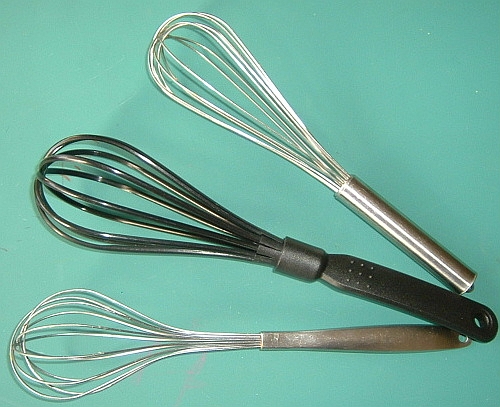Whisk on:
[Wikipedia]
[Google]
[Amazon]
 A whisk is a
A whisk is a
 Bundles of twigs, typically
Bundles of twigs, typically
cooking utensil
A kitchen utensil is a small hand-held tool used for food preparation. Common kitchen tasks include cutting food items to size, heating food on an open fire or on a stove, baking, grinding, mixing, blending, and measuring; different utensils ar ...
which can be used to blend ingredients smooth or to incorporate air into a mixture, in a process known as '' whisking'' or ''whipping
Flagellation (Latin , 'whip'), flogging or whipping is the act of beating the human body with special implements such as whips, rods, switches, the cat o' nine tails, the sjambok, the knout, etc. Typically, flogging has been imposed on ...
''. Most whisks consist of a long, narrow handle with a series of wire loops joined at the end. The loops can have different shapes depending on a whisk's intended functions. The wires are usually metal, but some are plastic
Plastics are a wide range of synthetic polymers, synthetic or Semisynthesis, semisynthetic materials composed primarily of Polymer, polymers. Their defining characteristic, Plasticity (physics), plasticity, allows them to be Injection moulding ...
for use with nonstick cookware. Whisks are also made from bamboo
Bamboos are a diverse group of mostly evergreen perennial plant, perennial flowering plants making up the subfamily (biology), subfamily Bambusoideae of the grass family Poaceae. Giant bamboos are the largest members of the grass family, in th ...
.
Whisks are commonly used to whip egg whites into a firm foam to make meringue
Meringue ( , ) is a type of dessert or candy, of French cuisine, French origin, traditionally made from Whisk, whipped egg whites and sugar, and occasionally an acid, acidic ingredient such as lemon, vinegar, or potassium bitartrate, cream of t ...
, or to whip cream
Cream is a dairy product composed of the higher-fat layer skimmed from the top of milk before homogenization. In un-homogenized milk, the fat, which is less dense, eventually rises to the top. In the industrial production of cream, this proces ...
into whipped cream
Whipped cream, also known as Chantilly cream or (), is high-fat dairy cream that has been aerated by whisking until it becomes light, fluffy, and capable of holding its shape. This process incorporates air into the cream, creating a semi-soli ...
.
Etymology
The word ''whisk'', given its similarity to equivalent words in modernScandinavian languages
The North Germanic languages make up one of the three branches of the Germanic languages—a sub-family of the Indo-European languages—along with the West Germanic languages and the extinct East Germanic languages. The language group is al ...
, was probably borrowed from Old Norse
Old Norse, also referred to as Old Nordic or Old Scandinavian, was a stage of development of North Germanic languages, North Germanic dialects before their final divergence into separate Nordic languages. Old Norse was spoken by inhabitants ...
. It had early use in the Scots language as and .
History
 Bundles of twigs, typically
Bundles of twigs, typically apple
An apple is a round, edible fruit produced by an apple tree (''Malus'' spp.). Fruit trees of the orchard or domestic apple (''Malus domestica''), the most widely grown in the genus, are agriculture, cultivated worldwide. The tree originated ...
, have long been used as whisks; often the wood used would lend a certain fragrance to the dish. An 18th-century Shaker recipe calls to "Cut a handful of peach
The peach (''Prunus persica'') is a deciduous tree first domesticated and Agriculture, cultivated in China. It bears edible juicy fruits with various characteristics, most called peaches and the glossy-skinned, non-fuzzy varieties called necta ...
twigs which are filled with sap at this season of the year. Clip the ends and bruise them and beat the cake batter with them. This will impart a delicate peach flavor to the cake."
The bamboo whisk or was invented in the late 15th century by Murata Jukō, who commissioned its production by Takayama Minbunojo Nyudo Sosetsu. were presented to Emperor Go-Tsuchimikado. The process of producing was kept secret and passed on by patrilineally by family craftsmen for hundreds of years.
The wire whisk was invented sometime before 1841.
In the United States, cranked rotary egg beaters became more popular than whisks in the 20th century. Julia Child
Julia Carolyn Child (Birth name#Maiden and married names, née McWilliams; August 15, 1912 – August 13, 2004) was an American chef, author, and television personality. She is recognized for having brought French cuisine to the American pu ...
is credited with re-introducing the wire whisk in her first ever televised appearance, in 1963.
Types
Mechanisms
Since the 19th century, various mechanical devices have been designed to make whisking more efficient, under the names "egg beater", "rotary mixer", etc.See also
* Fly-whisk: for brushing away flies * Mixer (cooking) * Pastry blenderReferences
{{Bartend Food preparation utensils Bartending equipment